Here are 3 easy ways to remove the white film and residue from dishes after being ran in the dishwasher plus tips and tricks to keep it from coming back.
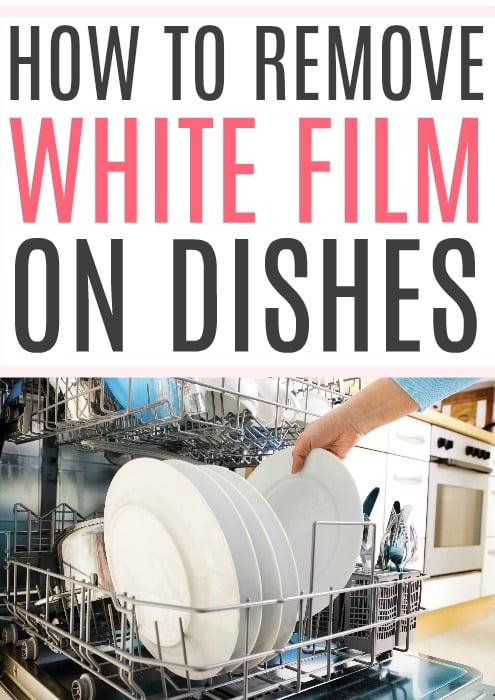
Normally I buy my dishwasher detergent from Aldi or I make my own. But, recently I was at a different store and bought their generic dishwasher detergent.
The first time I used the dish detergent I realized it left a white film on all of my dishes. We have hard water so that does happen occasionally.
I threw out the dishwasher detergent and then spent some time removing the white film from the dishes.
Even though the white film doesn't really hurt anything and your dishes are clean it is annoying to me. I want my dishes to look clean and pretty.
So, if you are like me and dealing with the film on dishes from the dishwasher check out these easy tips on how to remove white film on dishes.
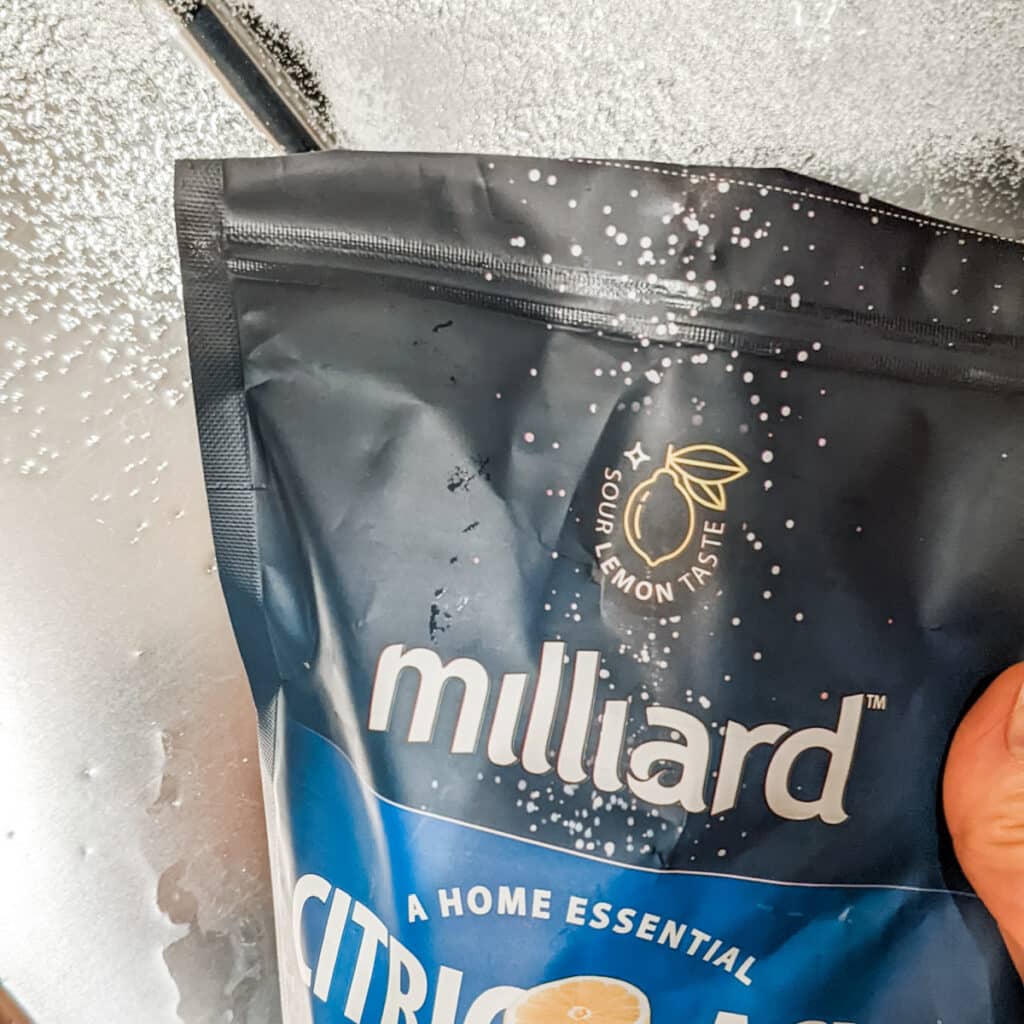
What is the White Residue on Dishes After Washing in the Dishwasher?
The white residue or film on dishes after being washed in the dishwasher is usually caused by hard water mineral deposits, specifically calcium and magnesium. When the dishwasher rinses your dishes, these minerals can be left behind and form a film or white powder, especially if the water in your area is particularly hard. Other factors that can contribute to this residue include:
- Insufficient Rinsing: If the dishwasher doesn't completely rinse the dishes, detergent and mineral residues can remain on them, appearing as a white spot.
- Type and Amount of Detergent: Using too much detergent or using a type that isn't suited to hard water can leave a residue. Some detergents also don't dissolve well in hard water.
- Water Temperature: Lower water temperatures may not dissolve detergent thoroughly, contributing to the residue.
The most common reasons you may be left with a milky film on your dishes is due to using a phosphate-free dishwasher detergent. The phosphates in dish detergents would help deal with hard water and minerals in the dishwasher, but now they are slowly being removed from dish detergents and dishwasher pods.
How to Test For Hard Water
Testing whether you have hard water at home can be done through several methods, ranging from simple DIY tests to a more detailed analysis. Here’s how you can check:
- Soap Suds Test: One of the simplest ways to test for water hardness is to see how well soap lathers with your water. Fill a spray bottle with water about one-third full, add a few drops of dish soap, and shake vigorously. If the water doesn’t produce many suds and the solution appears cloudy and milky, you likely have hard water.
- DIY Hard Water Test Kits: You can purchase a hard water test kit at most hardware or home improvement stores. These kits usually include strips that you dip into your water. The strip will change color according to the concentration of minerals like calcium and magnesium, indicating the level of hardness.
- Professional Water Test: For a more detailed analysis, you can send a sample of your water to a laboratory for testing. This can provide you with a full breakdown of your water’s mineral content and other characteristics.
- Check with Your Municipality: If you’re using city water, your local water supply can provide a water quality report that includes hardness levels. This is a straightforward way to learn about the water quality in your area.
Each of these methods can help you determine the hardness of your water, which can be useful for deciding whether you need to take steps to soften your water and prevent issues like scale buildup in your plumbing and on your dishes.
3 Ways to Remove the White Chalky Residue From Dishes
There are three main ways to get rid of white film on dishes from the dishwasher. All of them are pretty easy to do and won't take a lot of time.
Depending on which method you use you will need some of the items below.
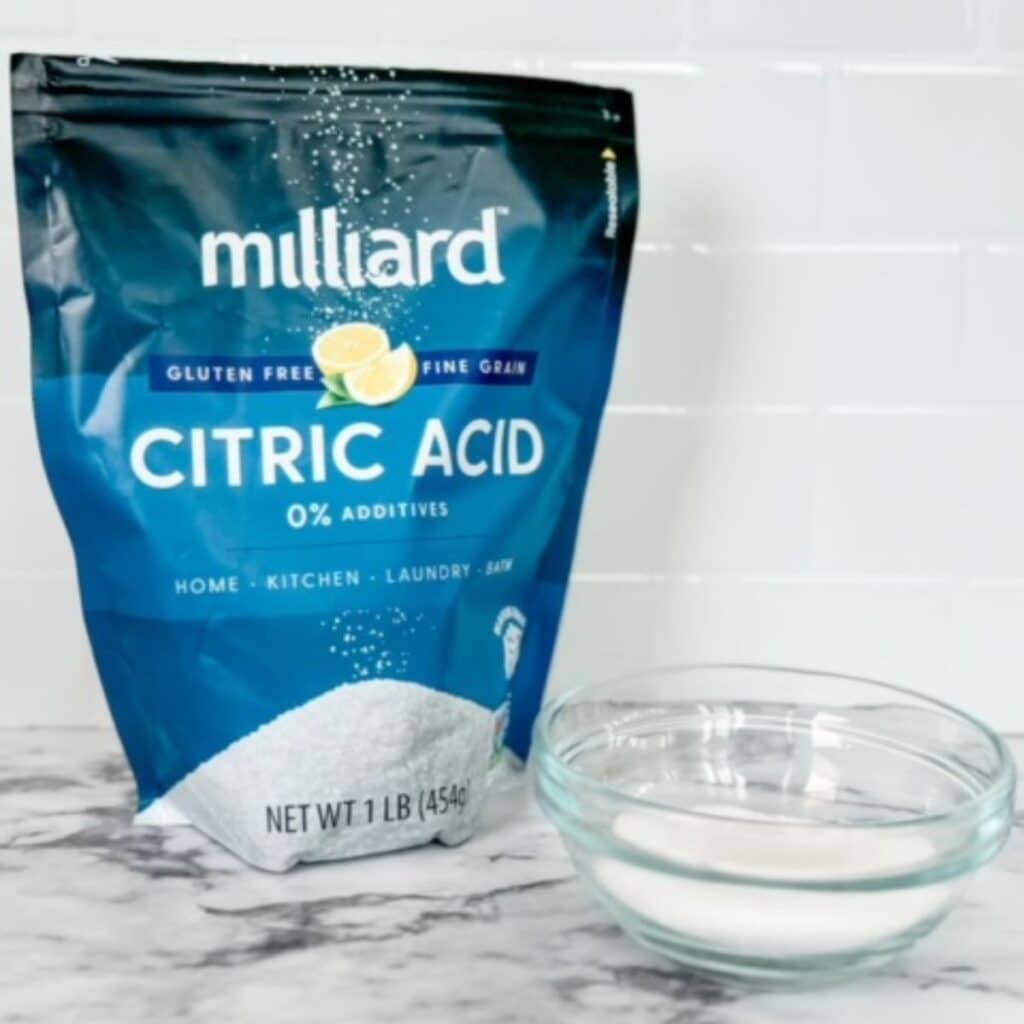
Citric Acid
If you don't have a lot of build-up of white film on your dishes you can usually wash them in the dishwasher to remove the film. This is by far the easiest way to get rid of white spots on dishes.
Be sure there is not any food residue, you will want to only do this with cloudy dishes that have already been run through a cleaning cycle.
STEP 1: Place all the dishes that are filmy in the dishwasher. Make sure they have plenty of room and aren't piled on top of each other.
STEP 2: Fill up all of your soap dispensers (including where a rinse agent would go) with citric acid. It can be bought in some stores or on Amazon. Then sprinkle a little bit ( I used about 1 cup) in the bottom of the dishwasher tub. Add a little more to a small bowl and place the bowl on the bottom rack.
STEP 3: Run on a normal wash cycle.
If you find that after a complete cycle there's still some residue, repeat the process one more time.
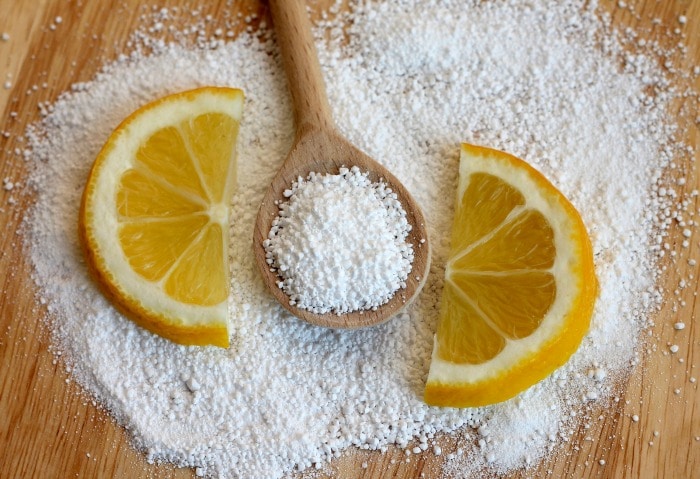
Vinegar Soak
If you have months or years of white film build-up on your dishes you may need to soak the dishes in vinegar to remove white film. This takes a little longer than quickly washing them in the dishwasher, but makes a big difference on heavy film.
STEP 1: Fill your sink up with enough water so it will cover the dishes. Use hot water or warm water.
STEP 2: Add a cup of vinegar (or up to 1.5 cups of white vinegar) and mix into the water.
STEP 3: Place the dishes in, being careful not to over stack. You want them to be submerged. Allow them to soak for up to 2 hours. Repeat in batches if needed.
STEP 4: Drain the vinegar solution and rinse the dishes off.
STEP 5: Place the clean dishes in the dishwasher and run on a normal dishwashing cycle.
You can also do this method using citric acid if you prefer. I personally think they need a little less soaking time with citric acid than with vinegar. Just make sure you use warm enough water for the powder to dissolve.
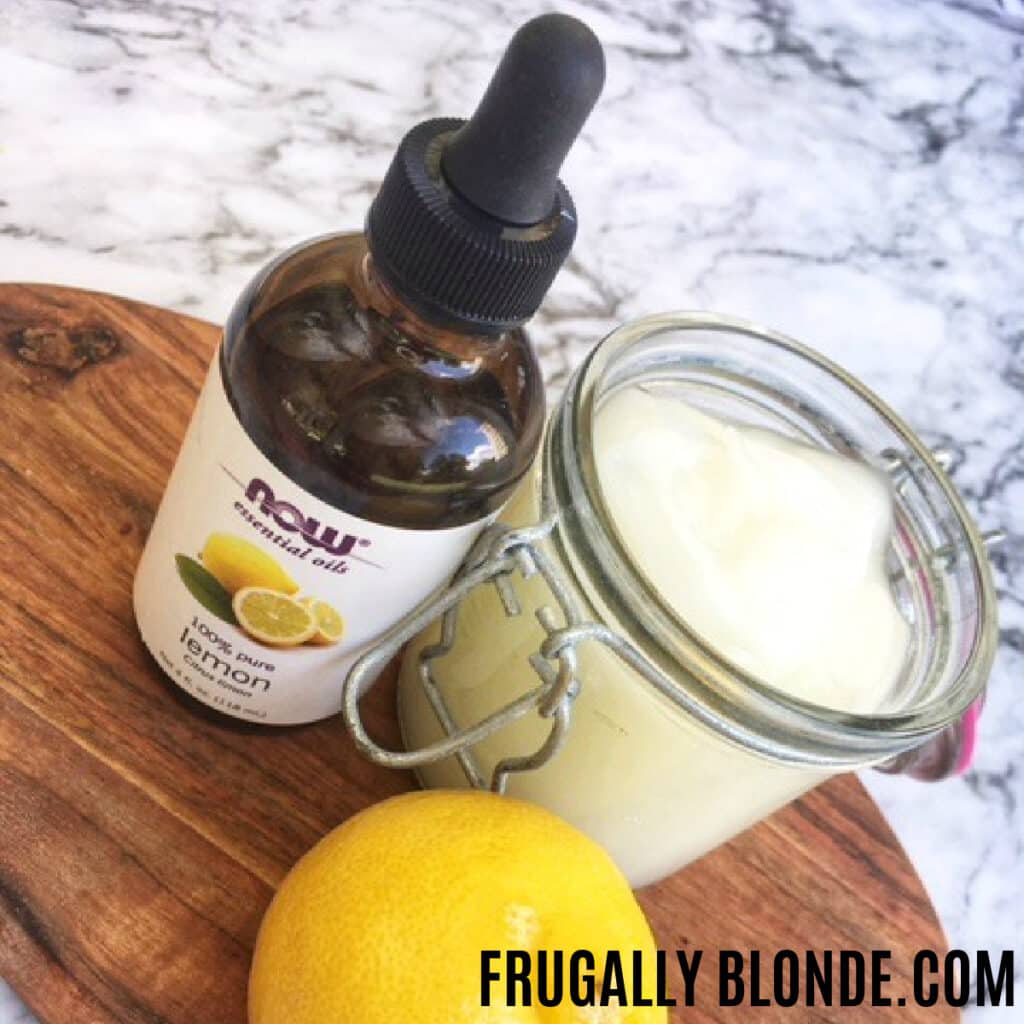
Vinegar Gel
Using vinegar gel to remove white film on dishes isn't the easiest way, but works great on large items that can't soak in the sink. It also works well if you have a spot or two that remains on your dishes after using the dishwasher method.
Grab store-bought vinegar gel or make your own homemade vinegar gel.
STEP 1: Apply a small amount of the vinegar gel over the area with the film. Let it soak on there for about 1-2 hours. Then rinse the gel off. Because it is a gel it will stick to the areas you need it to without getting too runny. It has the power of vinegar with a gel form.
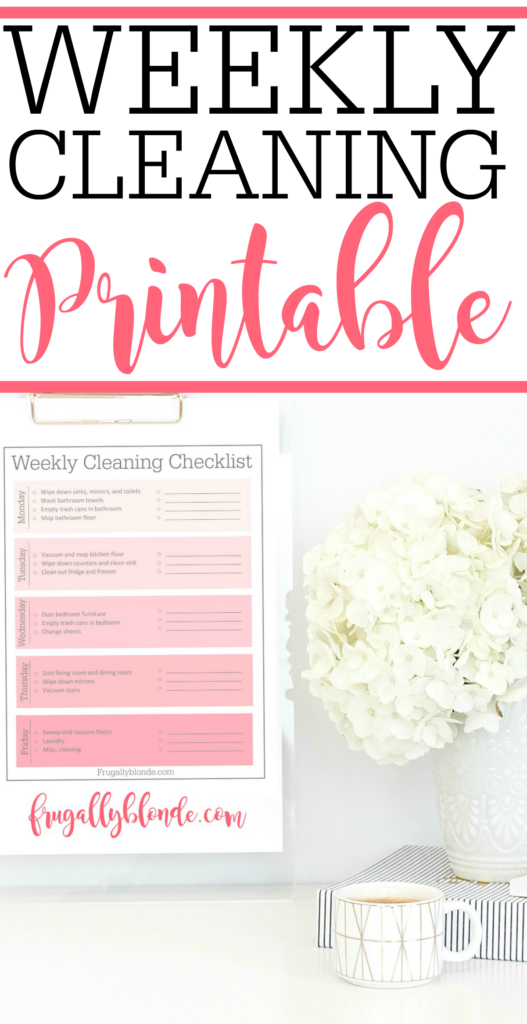
Free Weekly Cleaning Printable
Clean your home in under 30 minutes a day with this free Weekly Cleaning printable!
Helpful Tips
I love these homemade dish tabs for preventing white film on dishes. You can also use a little citric acid in every load of dishes you run. It does a great job of preventing the film.
If you constantly notice the white streaks even after getting rid of it, its a good idea to switch to a different brand of detergent.
Noticing hard water deposits in other areas? Here's how to remove mineral buildup from faucets and how to clean water spots and hard water stains from glasses.
If you already know you live in a hard water area, you may want to check on adding a water softener.
Using too much dishwashing detergent could also be another reason why you are seeing white spots because the final rinse cycle doesn't have enough power to remove all of it.
Adding a dishwasher rinse aid can be helpful because it aids in getting most of the water off of the dishes, so the dry cycle will work better.
New dishwashers have different settings, so be sure you always use the hottest water possible.
Don't overload the dishwasher, and load it properly. Use the upper rack for plastics, glasses, and bowl. Stagger the larger dishes and plates on the lower rack so the detergent reaches everything.
Be sure to check out these simple tips so your dishwasher runs like new again. This is perfect for those with older dishwashers or if you are finding it's just not doing the job like it used to.
How to Descale a Dishwasher
From time to time it's important to give your dishwasher a good cleaning. Once a month I use citric acid to clean the interior of the dishwasher and also wash the filter. See how to deep clean your dishwasher.
If you notice heavy buildup on the dishwasher spray arms you can give a scrub with an old toothbrush.
Be sure to always rinse off large food particles, over time this causes the filter to get extra dirty.




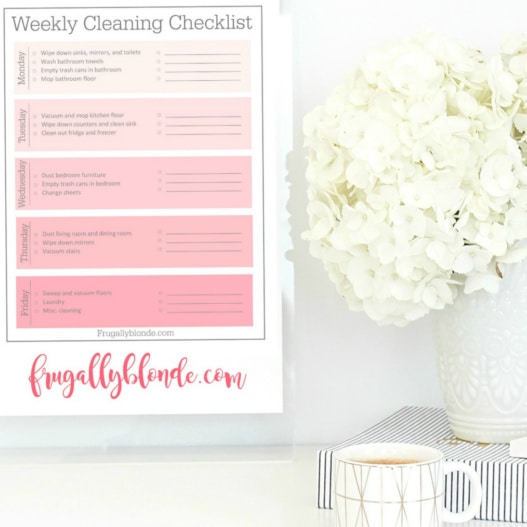
Leave a Reply